Management Accounting Report: Budgetary Control and Costing
VerifiedAdded on 2020/10/22
|10
|3301
|79
Report
AI Summary
This report delves into the core concepts of management accounting, exploring topics such as marginal and absorption costing, and their implications on profit calculations. It examines the advantages and disadvantages of various planning tools used in budgetary control, including fixed, flexible, incremental, and zero-based budgets. The report also highlights the application of variance analysis in assessing financial performance. Furthermore, it analyzes how organizations adapt their management accounting systems to address financial challenges and evaluates the effectiveness of management accounting in achieving sustainable success. The report provides a comprehensive overview of these key areas, offering valuable insights into financial management practices.
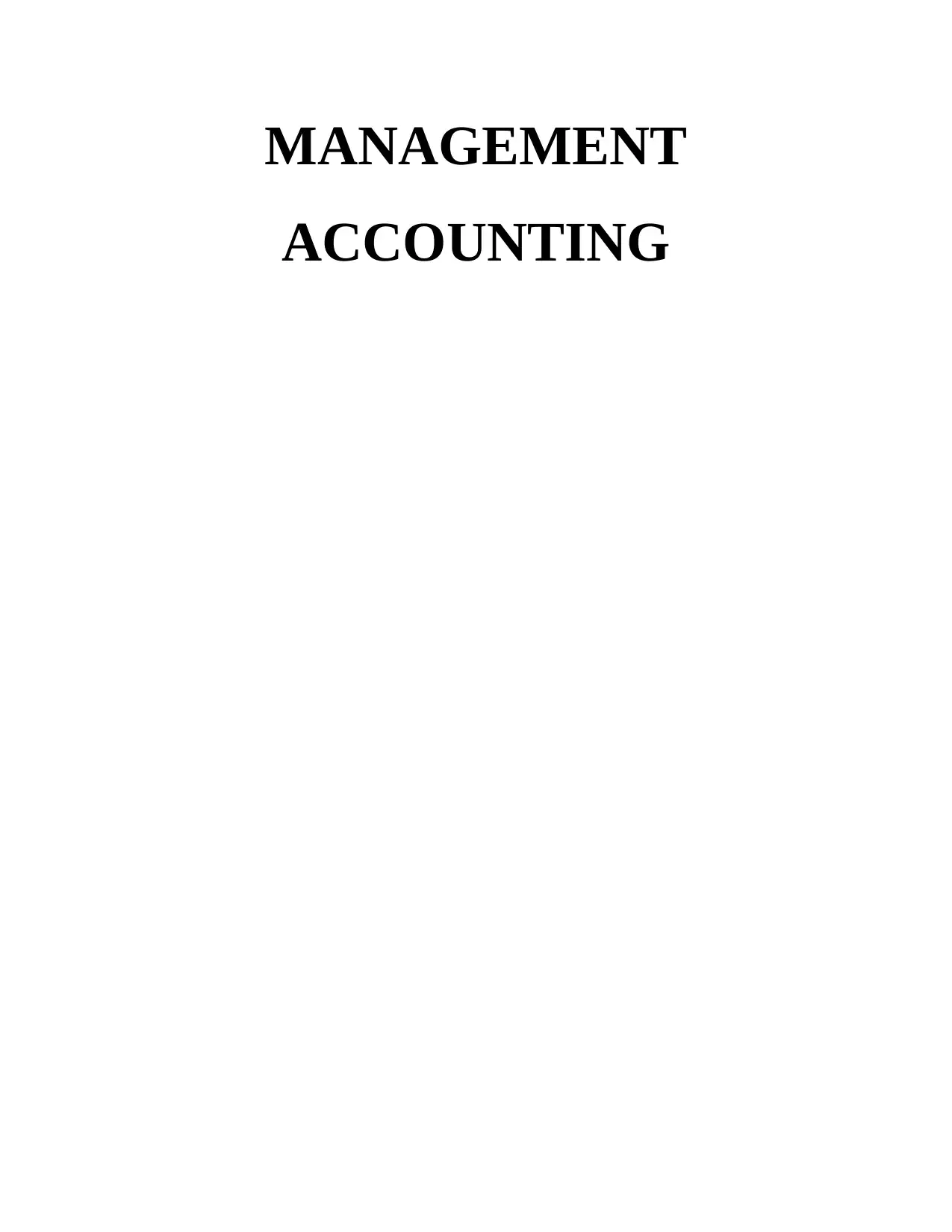
MANAGEMENT
ACCOUNTING
ACCOUNTING
Paraphrase This Document
Need a fresh take? Get an instant paraphrase of this document with our AI Paraphraser
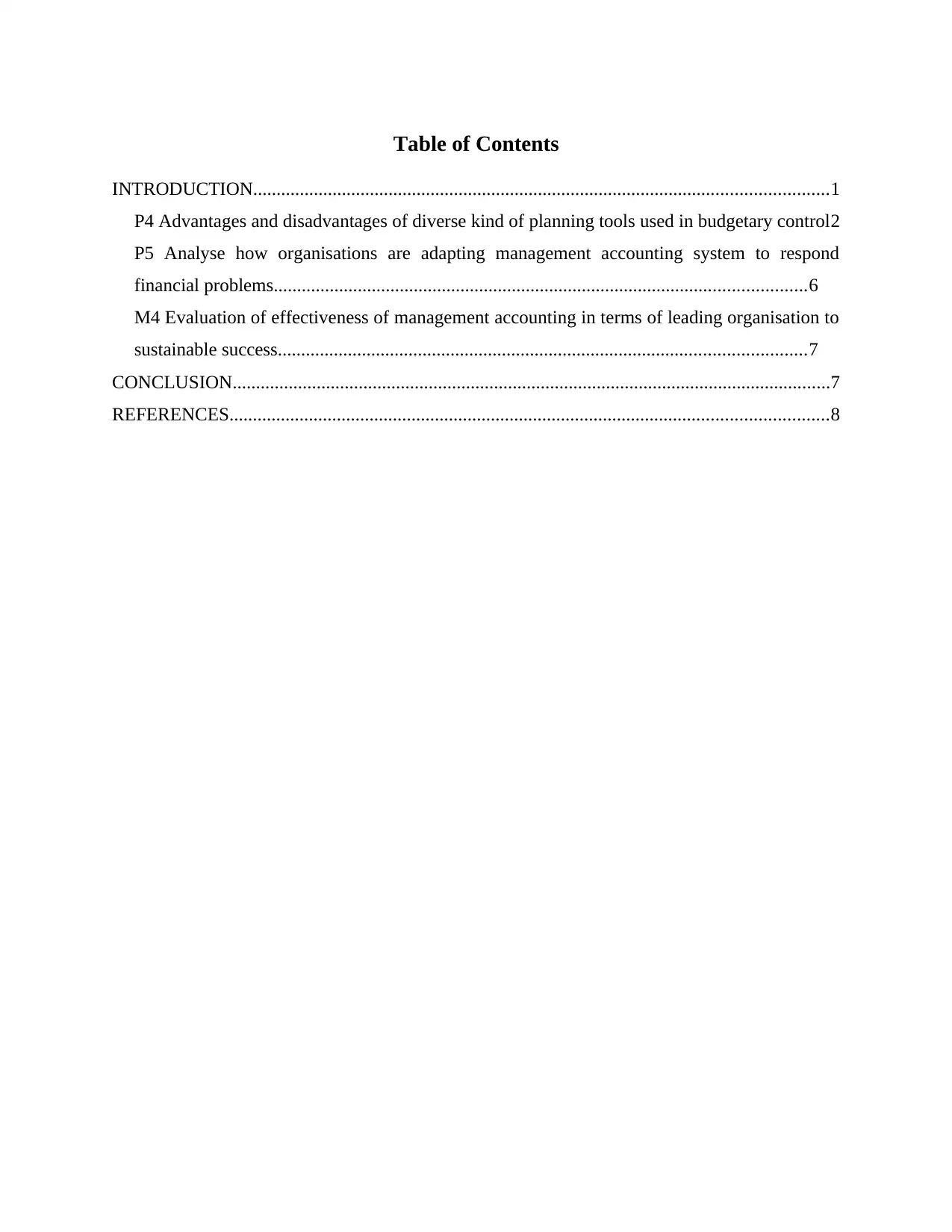
Table of Contents
INTRODUCTION...........................................................................................................................1
P4 Advantages and disadvantages of diverse kind of planning tools used in budgetary control2
P5 Analyse how organisations are adapting management accounting system to respond
financial problems..................................................................................................................6
M4 Evaluation of effectiveness of management accounting in terms of leading organisation to
sustainable success.................................................................................................................7
CONCLUSION................................................................................................................................7
REFERENCES................................................................................................................................8
INTRODUCTION...........................................................................................................................1
P4 Advantages and disadvantages of diverse kind of planning tools used in budgetary control2
P5 Analyse how organisations are adapting management accounting system to respond
financial problems..................................................................................................................6
M4 Evaluation of effectiveness of management accounting in terms of leading organisation to
sustainable success.................................................................................................................7
CONCLUSION................................................................................................................................7
REFERENCES................................................................................................................................8
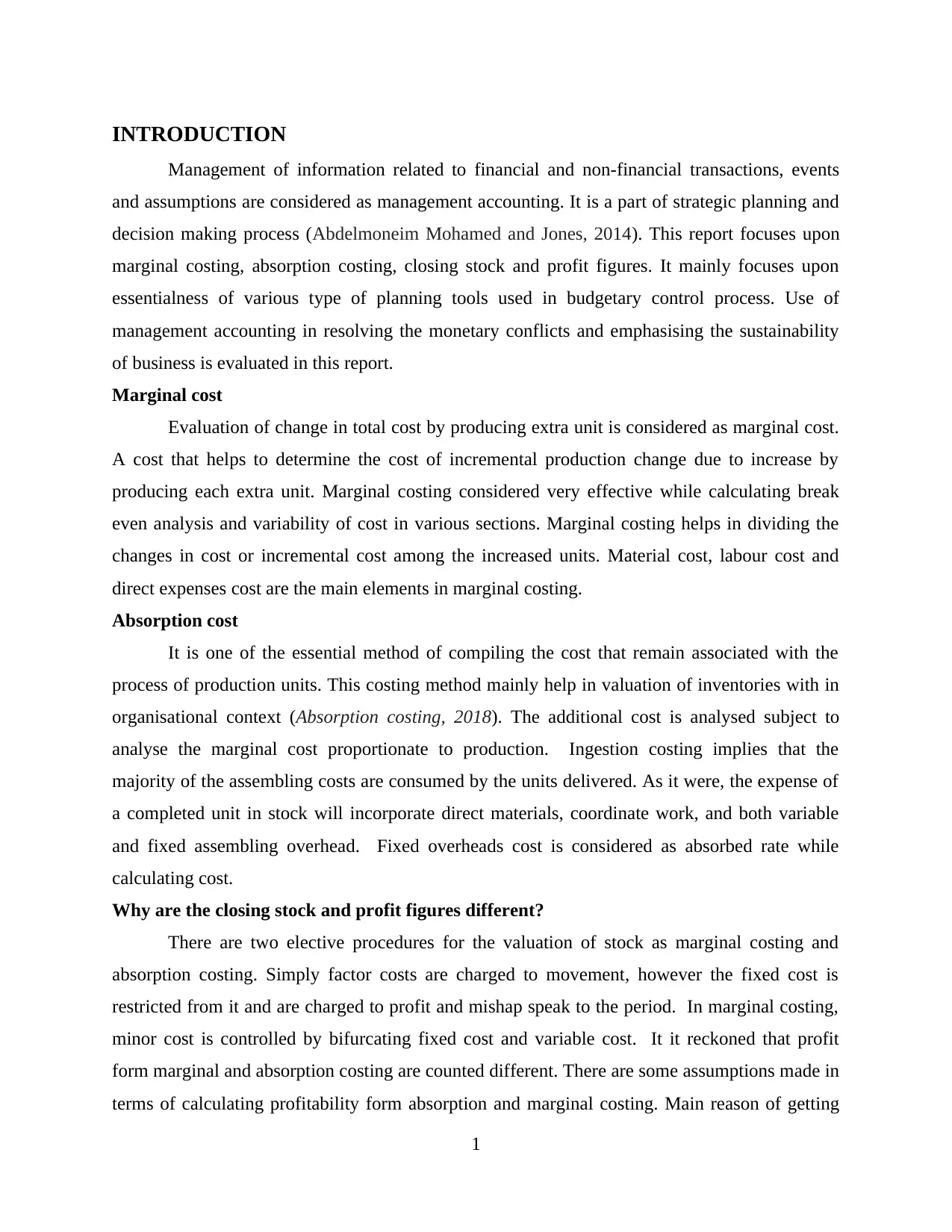
INTRODUCTION
Management of information related to financial and non-financial transactions, events
and assumptions are considered as management accounting. It is a part of strategic planning and
decision making process (Abdelmoneim Mohamed and Jones, 2014). This report focuses upon
marginal costing, absorption costing, closing stock and profit figures. It mainly focuses upon
essentialness of various type of planning tools used in budgetary control process. Use of
management accounting in resolving the monetary conflicts and emphasising the sustainability
of business is evaluated in this report.
Marginal cost
Evaluation of change in total cost by producing extra unit is considered as marginal cost.
A cost that helps to determine the cost of incremental production change due to increase by
producing each extra unit. Marginal costing considered very effective while calculating break
even analysis and variability of cost in various sections. Marginal costing helps in dividing the
changes in cost or incremental cost among the increased units. Material cost, labour cost and
direct expenses cost are the main elements in marginal costing.
Absorption cost
It is one of the essential method of compiling the cost that remain associated with the
process of production units. This costing method mainly help in valuation of inventories with in
organisational context (Absorption costing, 2018). The additional cost is analysed subject to
analyse the marginal cost proportionate to production. Ingestion costing implies that the
majority of the assembling costs are consumed by the units delivered. As it were, the expense of
a completed unit in stock will incorporate direct materials, coordinate work, and both variable
and fixed assembling overhead. Fixed overheads cost is considered as absorbed rate while
calculating cost.
Why are the closing stock and profit figures different?
There are two elective procedures for the valuation of stock as marginal costing and
absorption costing. Simply factor costs are charged to movement, however the fixed cost is
restricted from it and are charged to profit and mishap speak to the period. In marginal costing,
minor cost is controlled by bifurcating fixed cost and variable cost. It it reckoned that profit
form marginal and absorption costing are counted different. There are some assumptions made in
terms of calculating profitability form absorption and marginal costing. Main reason of getting
1
Management of information related to financial and non-financial transactions, events
and assumptions are considered as management accounting. It is a part of strategic planning and
decision making process (Abdelmoneim Mohamed and Jones, 2014). This report focuses upon
marginal costing, absorption costing, closing stock and profit figures. It mainly focuses upon
essentialness of various type of planning tools used in budgetary control process. Use of
management accounting in resolving the monetary conflicts and emphasising the sustainability
of business is evaluated in this report.
Marginal cost
Evaluation of change in total cost by producing extra unit is considered as marginal cost.
A cost that helps to determine the cost of incremental production change due to increase by
producing each extra unit. Marginal costing considered very effective while calculating break
even analysis and variability of cost in various sections. Marginal costing helps in dividing the
changes in cost or incremental cost among the increased units. Material cost, labour cost and
direct expenses cost are the main elements in marginal costing.
Absorption cost
It is one of the essential method of compiling the cost that remain associated with the
process of production units. This costing method mainly help in valuation of inventories with in
organisational context (Absorption costing, 2018). The additional cost is analysed subject to
analyse the marginal cost proportionate to production. Ingestion costing implies that the
majority of the assembling costs are consumed by the units delivered. As it were, the expense of
a completed unit in stock will incorporate direct materials, coordinate work, and both variable
and fixed assembling overhead. Fixed overheads cost is considered as absorbed rate while
calculating cost.
Why are the closing stock and profit figures different?
There are two elective procedures for the valuation of stock as marginal costing and
absorption costing. Simply factor costs are charged to movement, however the fixed cost is
restricted from it and are charged to profit and mishap speak to the period. In marginal costing,
minor cost is controlled by bifurcating fixed cost and variable cost. It it reckoned that profit
form marginal and absorption costing are counted different. There are some assumptions made in
terms of calculating profitability form absorption and marginal costing. Main reason of getting
1
⊘ This is a preview!⊘
Do you want full access?
Subscribe today to unlock all pages.

Trusted by 1+ million students worldwide
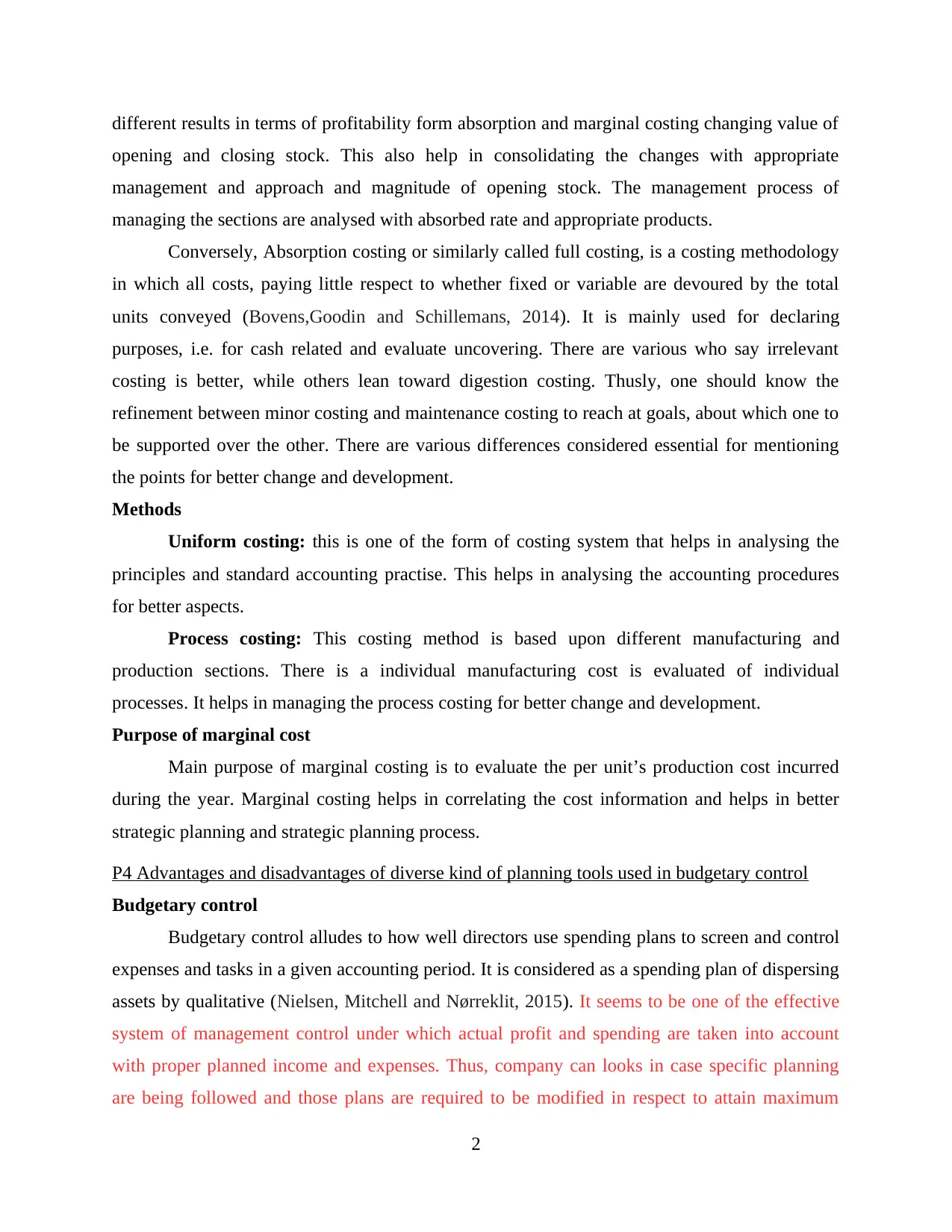
different results in terms of profitability form absorption and marginal costing changing value of
opening and closing stock. This also help in consolidating the changes with appropriate
management and approach and magnitude of opening stock. The management process of
managing the sections are analysed with absorbed rate and appropriate products.
Conversely, Absorption costing or similarly called full costing, is a costing methodology
in which all costs, paying little respect to whether fixed or variable are devoured by the total
units conveyed (Bovens,Goodin and Schillemans, 2014). It is mainly used for declaring
purposes, i.e. for cash related and evaluate uncovering. There are various who say irrelevant
costing is better, while others lean toward digestion costing. Thusly, one should know the
refinement between minor costing and maintenance costing to reach at goals, about which one to
be supported over the other. There are various differences considered essential for mentioning
the points for better change and development.
Methods
Uniform costing: this is one of the form of costing system that helps in analysing the
principles and standard accounting practise. This helps in analysing the accounting procedures
for better aspects.
Process costing: This costing method is based upon different manufacturing and
production sections. There is a individual manufacturing cost is evaluated of individual
processes. It helps in managing the process costing for better change and development.
Purpose of marginal cost
Main purpose of marginal costing is to evaluate the per unit’s production cost incurred
during the year. Marginal costing helps in correlating the cost information and helps in better
strategic planning and strategic planning process.
P4 Advantages and disadvantages of diverse kind of planning tools used in budgetary control
Budgetary control
Budgetary control alludes to how well directors use spending plans to screen and control
expenses and tasks in a given accounting period. It is considered as a spending plan of dispersing
assets by qualitative (Nielsen, Mitchell and Nørreklit, 2015). It seems to be one of the effective
system of management control under which actual profit and spending are taken into account
with proper planned income and expenses. Thus, company can looks in case specific planning
are being followed and those plans are required to be modified in respect to attain maximum
2
opening and closing stock. This also help in consolidating the changes with appropriate
management and approach and magnitude of opening stock. The management process of
managing the sections are analysed with absorbed rate and appropriate products.
Conversely, Absorption costing or similarly called full costing, is a costing methodology
in which all costs, paying little respect to whether fixed or variable are devoured by the total
units conveyed (Bovens,Goodin and Schillemans, 2014). It is mainly used for declaring
purposes, i.e. for cash related and evaluate uncovering. There are various who say irrelevant
costing is better, while others lean toward digestion costing. Thusly, one should know the
refinement between minor costing and maintenance costing to reach at goals, about which one to
be supported over the other. There are various differences considered essential for mentioning
the points for better change and development.
Methods
Uniform costing: this is one of the form of costing system that helps in analysing the
principles and standard accounting practise. This helps in analysing the accounting procedures
for better aspects.
Process costing: This costing method is based upon different manufacturing and
production sections. There is a individual manufacturing cost is evaluated of individual
processes. It helps in managing the process costing for better change and development.
Purpose of marginal cost
Main purpose of marginal costing is to evaluate the per unit’s production cost incurred
during the year. Marginal costing helps in correlating the cost information and helps in better
strategic planning and strategic planning process.
P4 Advantages and disadvantages of diverse kind of planning tools used in budgetary control
Budgetary control
Budgetary control alludes to how well directors use spending plans to screen and control
expenses and tasks in a given accounting period. It is considered as a spending plan of dispersing
assets by qualitative (Nielsen, Mitchell and Nørreklit, 2015). It seems to be one of the effective
system of management control under which actual profit and spending are taken into account
with proper planned income and expenses. Thus, company can looks in case specific planning
are being followed and those plans are required to be modified in respect to attain maximum
2
Paraphrase This Document
Need a fresh take? Get an instant paraphrase of this document with our AI Paraphraser
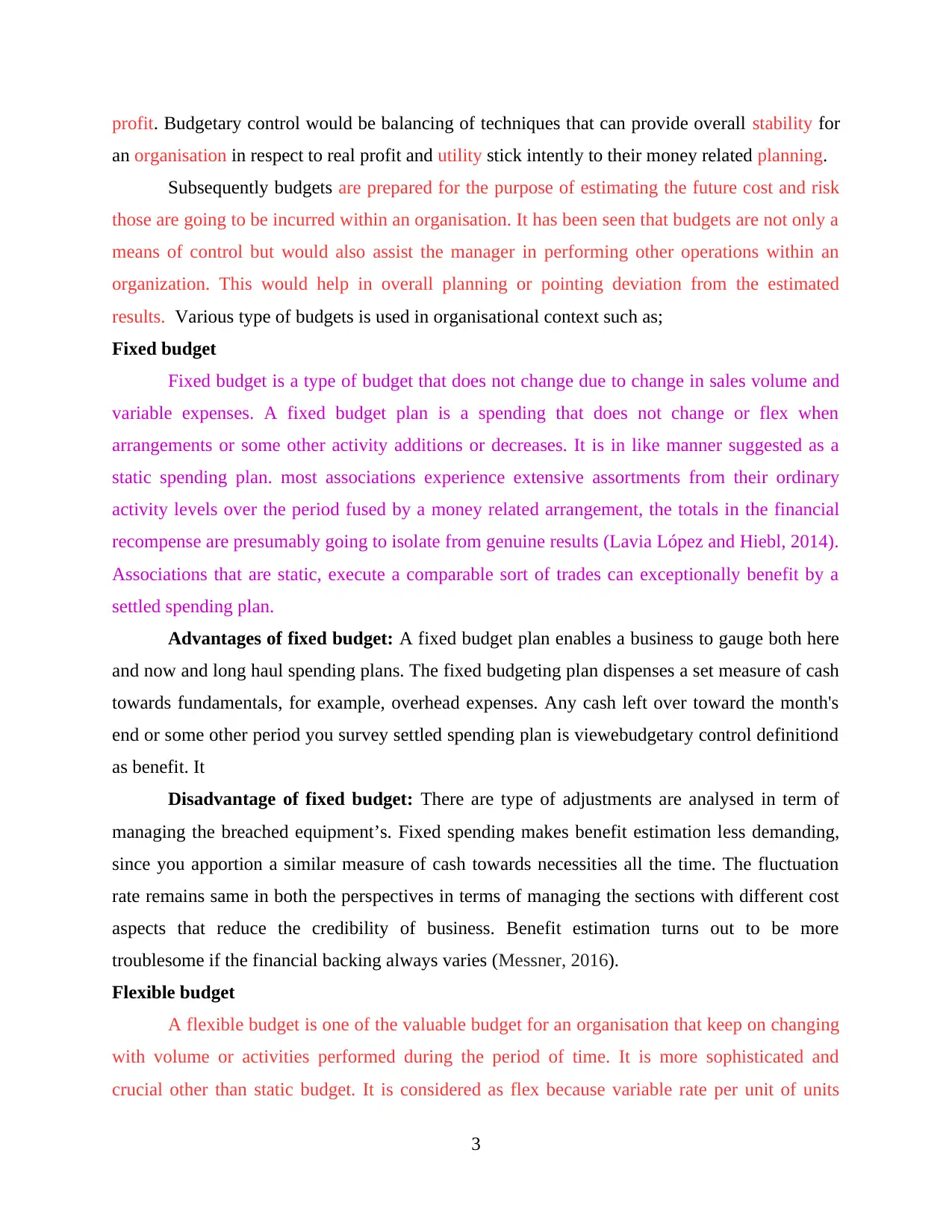
profit. Budgetary control would be balancing of techniques that can provide overall stability for
an organisation in respect to real profit and utility stick intently to their money related planning.
Subsequently budgets are prepared for the purpose of estimating the future cost and risk
those are going to be incurred within an organisation. It has been seen that budgets are not only a
means of control but would also assist the manager in performing other operations within an
organization. This would help in overall planning or pointing deviation from the estimated
results. Various type of budgets is used in organisational context such as;
Fixed budget
Fixed budget is a type of budget that does not change due to change in sales volume and
variable expenses. A fixed budget plan is a spending that does not change or flex when
arrangements or some other activity additions or decreases. It is in like manner suggested as a
static spending plan. most associations experience extensive assortments from their ordinary
activity levels over the period fused by a money related arrangement, the totals in the financial
recompense are presumably going to isolate from genuine results (Lavia López and Hiebl, 2014).
Associations that are static, execute a comparable sort of trades can exceptionally benefit by a
settled spending plan.
Advantages of fixed budget: A fixed budget plan enables a business to gauge both here
and now and long haul spending plans. The fixed budgeting plan dispenses a set measure of cash
towards fundamentals, for example, overhead expenses. Any cash left over toward the month's
end or some other period you survey settled spending plan is viewebudgetary control definitiond
as benefit. It
Disadvantage of fixed budget: There are type of adjustments are analysed in term of
managing the breached equipment’s. Fixed spending makes benefit estimation less demanding,
since you apportion a similar measure of cash towards necessities all the time. The fluctuation
rate remains same in both the perspectives in terms of managing the sections with different cost
aspects that reduce the credibility of business. Benefit estimation turns out to be more
troublesome if the financial backing always varies (Messner, 2016).
Flexible budget
A flexible budget is one of the valuable budget for an organisation that keep on changing
with volume or activities performed during the period of time. It is more sophisticated and
crucial other than static budget. It is considered as flex because variable rate per unit of units
3
an organisation in respect to real profit and utility stick intently to their money related planning.
Subsequently budgets are prepared for the purpose of estimating the future cost and risk
those are going to be incurred within an organisation. It has been seen that budgets are not only a
means of control but would also assist the manager in performing other operations within an
organization. This would help in overall planning or pointing deviation from the estimated
results. Various type of budgets is used in organisational context such as;
Fixed budget
Fixed budget is a type of budget that does not change due to change in sales volume and
variable expenses. A fixed budget plan is a spending that does not change or flex when
arrangements or some other activity additions or decreases. It is in like manner suggested as a
static spending plan. most associations experience extensive assortments from their ordinary
activity levels over the period fused by a money related arrangement, the totals in the financial
recompense are presumably going to isolate from genuine results (Lavia López and Hiebl, 2014).
Associations that are static, execute a comparable sort of trades can exceptionally benefit by a
settled spending plan.
Advantages of fixed budget: A fixed budget plan enables a business to gauge both here
and now and long haul spending plans. The fixed budgeting plan dispenses a set measure of cash
towards fundamentals, for example, overhead expenses. Any cash left over toward the month's
end or some other period you survey settled spending plan is viewebudgetary control definitiond
as benefit. It
Disadvantage of fixed budget: There are type of adjustments are analysed in term of
managing the breached equipment’s. Fixed spending makes benefit estimation less demanding,
since you apportion a similar measure of cash towards necessities all the time. The fluctuation
rate remains same in both the perspectives in terms of managing the sections with different cost
aspects that reduce the credibility of business. Benefit estimation turns out to be more
troublesome if the financial backing always varies (Messner, 2016).
Flexible budget
A flexible budget is one of the valuable budget for an organisation that keep on changing
with volume or activities performed during the period of time. It is more sophisticated and
crucial other than static budget. It is considered as flex because variable rate per unit of units
3
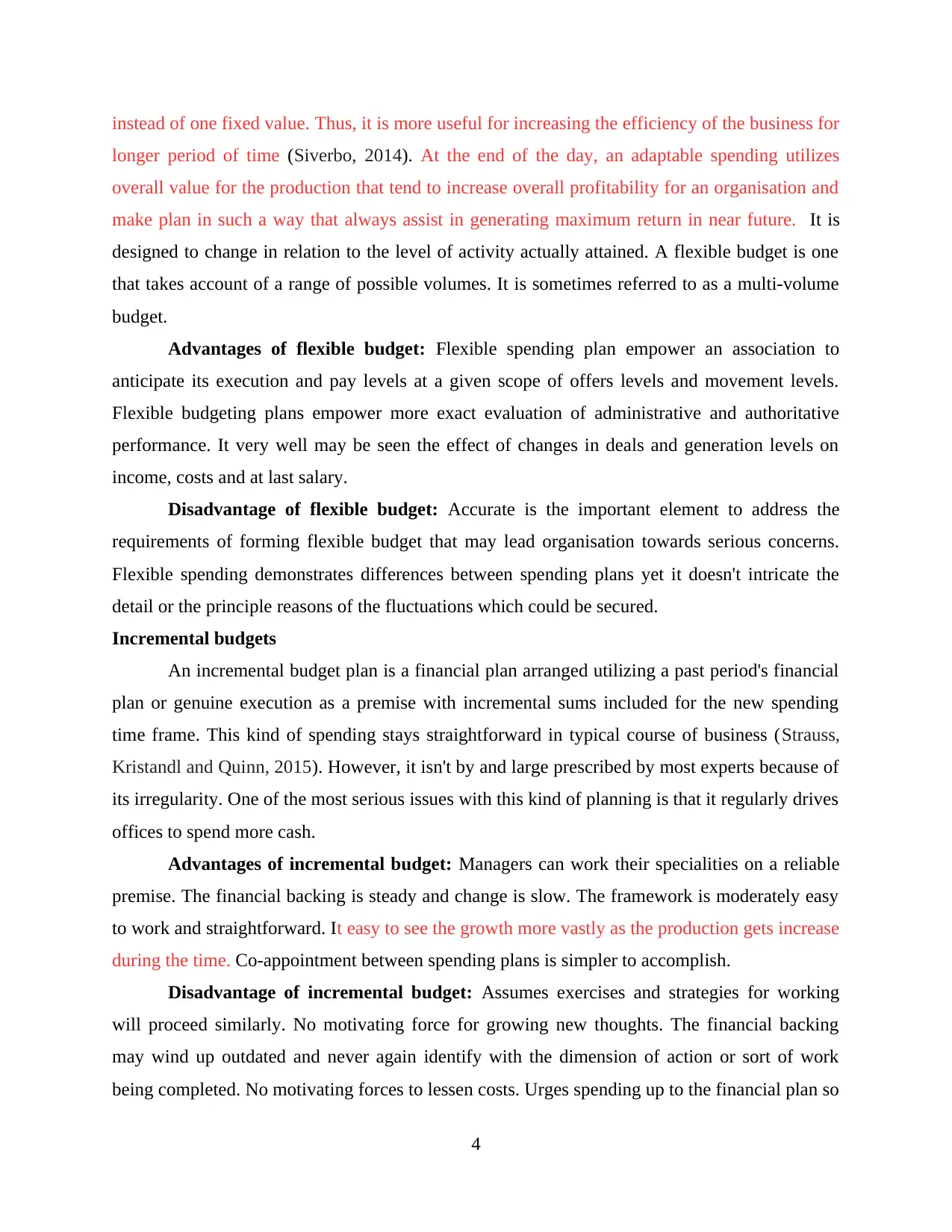
instead of one fixed value. Thus, it is more useful for increasing the efficiency of the business for
longer period of time (Siverbo, 2014). At the end of the day, an adaptable spending utilizes
overall value for the production that tend to increase overall profitability for an organisation and
make plan in such a way that always assist in generating maximum return in near future. It is
designed to change in relation to the level of activity actually attained. A flexible budget is one
that takes account of a range of possible volumes. It is sometimes referred to as a multi-volume
budget.
Advantages of flexible budget: Flexible spending plan empower an association to
anticipate its execution and pay levels at a given scope of offers levels and movement levels.
Flexible budgeting plans empower more exact evaluation of administrative and authoritative
performance. It very well may be seen the effect of changes in deals and generation levels on
income, costs and at last salary.
Disadvantage of flexible budget: Accurate is the important element to address the
requirements of forming flexible budget that may lead organisation towards serious concerns.
Flexible spending demonstrates differences between spending plans yet it doesn't intricate the
detail or the principle reasons of the fluctuations which could be secured.
Incremental budgets
An incremental budget plan is a financial plan arranged utilizing a past period's financial
plan or genuine execution as a premise with incremental sums included for the new spending
time frame. This kind of spending stays straightforward in typical course of business (Strauss,
Kristandl and Quinn, 2015). However, it isn't by and large prescribed by most experts because of
its irregularity. One of the most serious issues with this kind of planning is that it regularly drives
offices to spend more cash.
Advantages of incremental budget: Managers can work their specialities on a reliable
premise. The financial backing is steady and change is slow. The framework is moderately easy
to work and straightforward. It easy to see the growth more vastly as the production gets increase
during the time. Co-appointment between spending plans is simpler to accomplish.
Disadvantage of incremental budget: Assumes exercises and strategies for working
will proceed similarly. No motivating force for growing new thoughts. The financial backing
may wind up outdated and never again identify with the dimension of action or sort of work
being completed. No motivating forces to lessen costs. Urges spending up to the financial plan so
4
longer period of time (Siverbo, 2014). At the end of the day, an adaptable spending utilizes
overall value for the production that tend to increase overall profitability for an organisation and
make plan in such a way that always assist in generating maximum return in near future. It is
designed to change in relation to the level of activity actually attained. A flexible budget is one
that takes account of a range of possible volumes. It is sometimes referred to as a multi-volume
budget.
Advantages of flexible budget: Flexible spending plan empower an association to
anticipate its execution and pay levels at a given scope of offers levels and movement levels.
Flexible budgeting plans empower more exact evaluation of administrative and authoritative
performance. It very well may be seen the effect of changes in deals and generation levels on
income, costs and at last salary.
Disadvantage of flexible budget: Accurate is the important element to address the
requirements of forming flexible budget that may lead organisation towards serious concerns.
Flexible spending demonstrates differences between spending plans yet it doesn't intricate the
detail or the principle reasons of the fluctuations which could be secured.
Incremental budgets
An incremental budget plan is a financial plan arranged utilizing a past period's financial
plan or genuine execution as a premise with incremental sums included for the new spending
time frame. This kind of spending stays straightforward in typical course of business (Strauss,
Kristandl and Quinn, 2015). However, it isn't by and large prescribed by most experts because of
its irregularity. One of the most serious issues with this kind of planning is that it regularly drives
offices to spend more cash.
Advantages of incremental budget: Managers can work their specialities on a reliable
premise. The financial backing is steady and change is slow. The framework is moderately easy
to work and straightforward. It easy to see the growth more vastly as the production gets increase
during the time. Co-appointment between spending plans is simpler to accomplish.
Disadvantage of incremental budget: Assumes exercises and strategies for working
will proceed similarly. No motivating force for growing new thoughts. The financial backing
may wind up outdated and never again identify with the dimension of action or sort of work
being completed. No motivating forces to lessen costs. Urges spending up to the financial plan so
4
⊘ This is a preview!⊘
Do you want full access?
Subscribe today to unlock all pages.

Trusted by 1+ million students worldwide
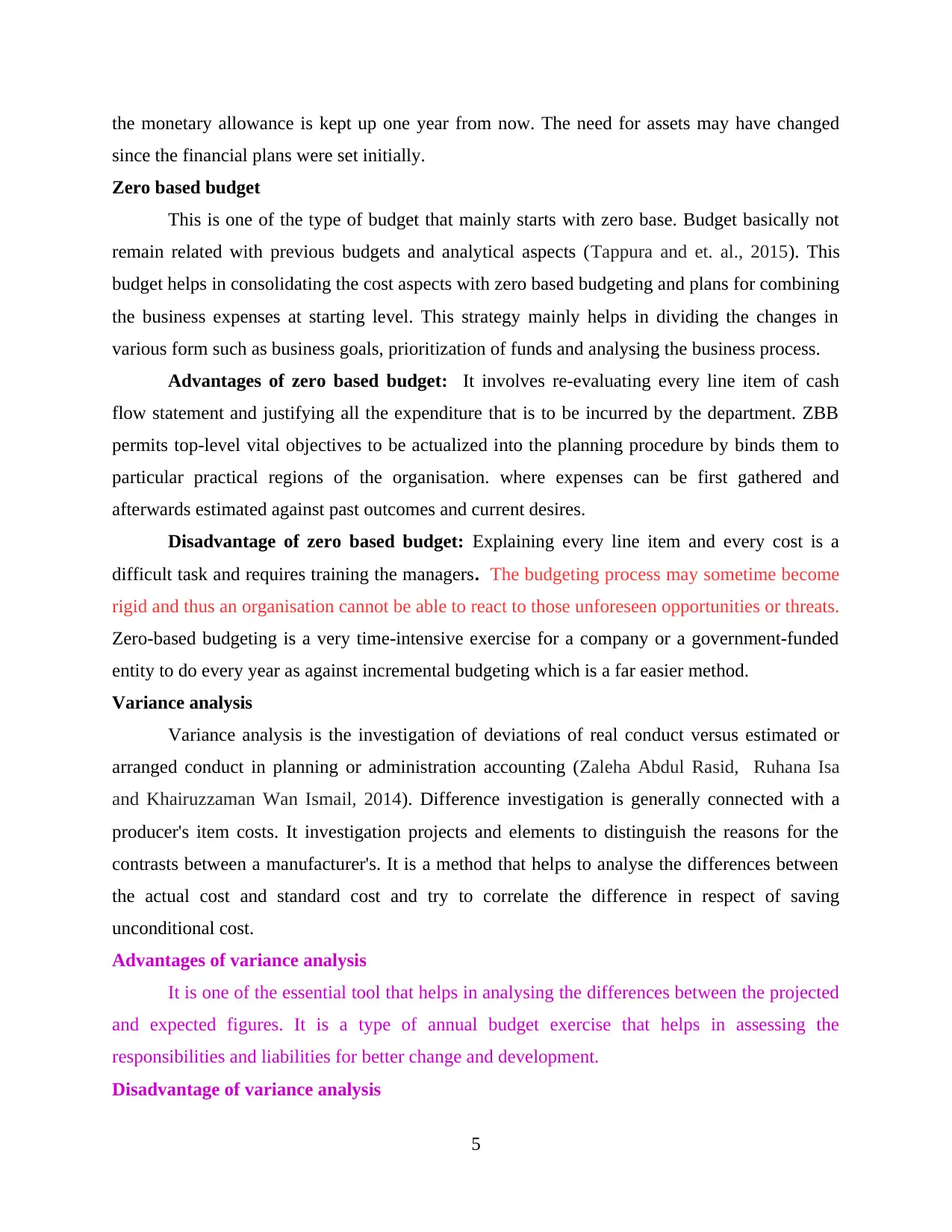
the monetary allowance is kept up one year from now. The need for assets may have changed
since the financial plans were set initially.
Zero based budget
This is one of the type of budget that mainly starts with zero base. Budget basically not
remain related with previous budgets and analytical aspects (Tappura and et. al., 2015). This
budget helps in consolidating the cost aspects with zero based budgeting and plans for combining
the business expenses at starting level. This strategy mainly helps in dividing the changes in
various form such as business goals, prioritization of funds and analysing the business process.
Advantages of zero based budget: It involves re-evaluating every line item of cash
flow statement and justifying all the expenditure that is to be incurred by the department. ZBB
permits top-level vital objectives to be actualized into the planning procedure by binds them to
particular practical regions of the organisation. where expenses can be first gathered and
afterwards estimated against past outcomes and current desires.
Disadvantage of zero based budget: Explaining every line item and every cost is a
difficult task and requires training the managers. The budgeting process may sometime become
rigid and thus an organisation cannot be able to react to those unforeseen opportunities or threats.
Zero-based budgeting is a very time-intensive exercise for a company or a government-funded
entity to do every year as against incremental budgeting which is a far easier method.
Variance analysis
Variance analysis is the investigation of deviations of real conduct versus estimated or
arranged conduct in planning or administration accounting (Zaleha Abdul Rasid, Ruhana Isa
and Khairuzzaman Wan Ismail, 2014). Difference investigation is generally connected with a
producer's item costs. It investigation projects and elements to distinguish the reasons for the
contrasts between a manufacturer's. It is a method that helps to analyse the differences between
the actual cost and standard cost and try to correlate the difference in respect of saving
unconditional cost.
Advantages of variance analysis
It is one of the essential tool that helps in analysing the differences between the projected
and expected figures. It is a type of annual budget exercise that helps in assessing the
responsibilities and liabilities for better change and development.
Disadvantage of variance analysis
5
since the financial plans were set initially.
Zero based budget
This is one of the type of budget that mainly starts with zero base. Budget basically not
remain related with previous budgets and analytical aspects (Tappura and et. al., 2015). This
budget helps in consolidating the cost aspects with zero based budgeting and plans for combining
the business expenses at starting level. This strategy mainly helps in dividing the changes in
various form such as business goals, prioritization of funds and analysing the business process.
Advantages of zero based budget: It involves re-evaluating every line item of cash
flow statement and justifying all the expenditure that is to be incurred by the department. ZBB
permits top-level vital objectives to be actualized into the planning procedure by binds them to
particular practical regions of the organisation. where expenses can be first gathered and
afterwards estimated against past outcomes and current desires.
Disadvantage of zero based budget: Explaining every line item and every cost is a
difficult task and requires training the managers. The budgeting process may sometime become
rigid and thus an organisation cannot be able to react to those unforeseen opportunities or threats.
Zero-based budgeting is a very time-intensive exercise for a company or a government-funded
entity to do every year as against incremental budgeting which is a far easier method.
Variance analysis
Variance analysis is the investigation of deviations of real conduct versus estimated or
arranged conduct in planning or administration accounting (Zaleha Abdul Rasid, Ruhana Isa
and Khairuzzaman Wan Ismail, 2014). Difference investigation is generally connected with a
producer's item costs. It investigation projects and elements to distinguish the reasons for the
contrasts between a manufacturer's. It is a method that helps to analyse the differences between
the actual cost and standard cost and try to correlate the difference in respect of saving
unconditional cost.
Advantages of variance analysis
It is one of the essential tool that helps in analysing the differences between the projected
and expected figures. It is a type of annual budget exercise that helps in assessing the
responsibilities and liabilities for better change and development.
Disadvantage of variance analysis
5
Paraphrase This Document
Need a fresh take? Get an instant paraphrase of this document with our AI Paraphraser
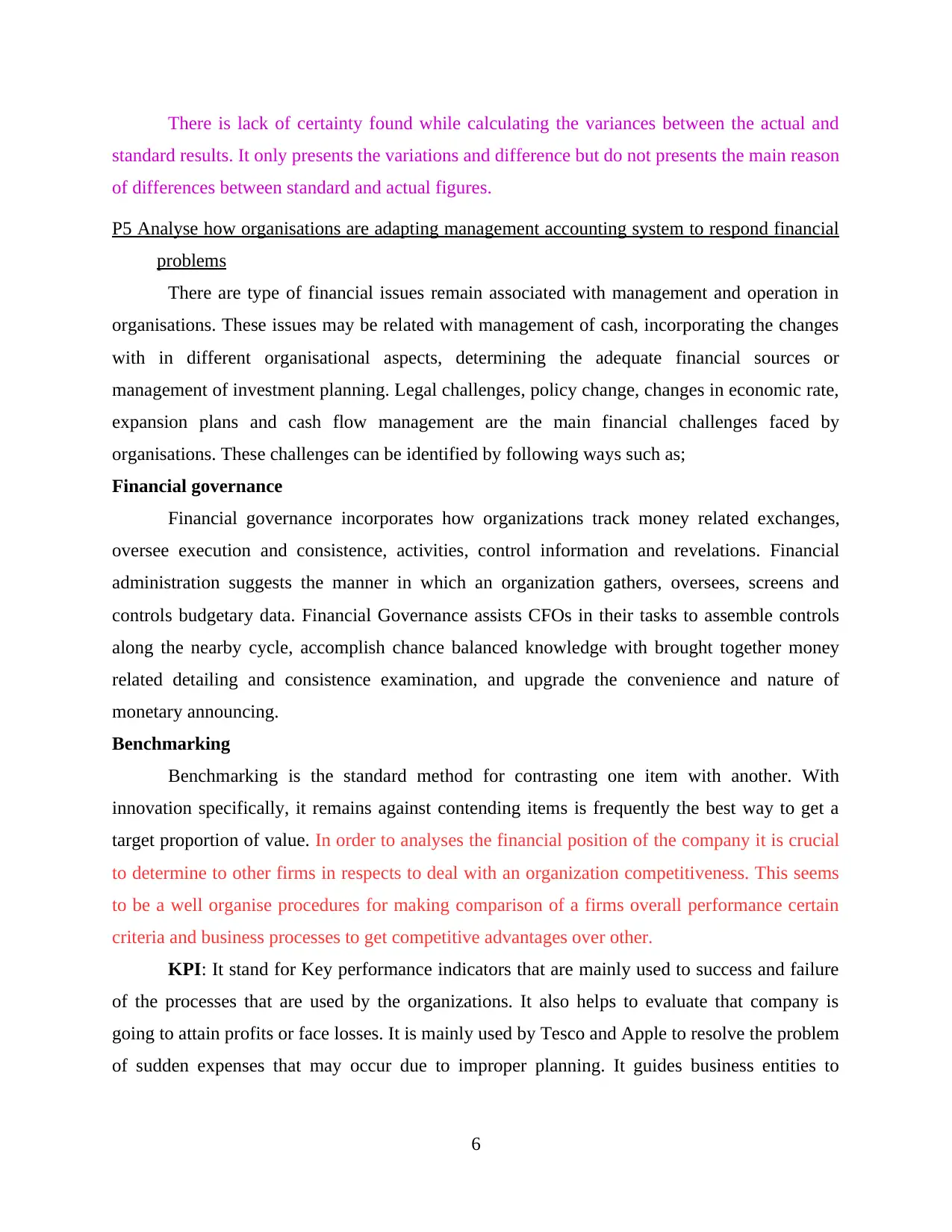
There is lack of certainty found while calculating the variances between the actual and
standard results. It only presents the variations and difference but do not presents the main reason
of differences between standard and actual figures.
P5 Analyse how organisations are adapting management accounting system to respond financial
problems
There are type of financial issues remain associated with management and operation in
organisations. These issues may be related with management of cash, incorporating the changes
with in different organisational aspects, determining the adequate financial sources or
management of investment planning. Legal challenges, policy change, changes in economic rate,
expansion plans and cash flow management are the main financial challenges faced by
organisations. These challenges can be identified by following ways such as;
Financial governance
Financial governance incorporates how organizations track money related exchanges,
oversee execution and consistence, activities, control information and revelations. Financial
administration suggests the manner in which an organization gathers, oversees, screens and
controls budgetary data. Financial Governance assists CFOs in their tasks to assemble controls
along the nearby cycle, accomplish chance balanced knowledge with brought together money
related detailing and consistence examination, and upgrade the convenience and nature of
monetary announcing.
Benchmarking
Benchmarking is the standard method for contrasting one item with another. With
innovation specifically, it remains against contending items is frequently the best way to get a
target proportion of value. In order to analyses the financial position of the company it is crucial
to determine to other firms in respects to deal with an organization competitiveness. This seems
to be a well organise procedures for making comparison of a firms overall performance certain
criteria and business processes to get competitive advantages over other.
KPI: It stand for Key performance indicators that are mainly used to success and failure
of the processes that are used by the organizations. It also helps to evaluate that company is
going to attain profits or face losses. It is mainly used by Tesco and Apple to resolve the problem
of sudden expenses that may occur due to improper planning. It guides business entities to
6
standard results. It only presents the variations and difference but do not presents the main reason
of differences between standard and actual figures.
P5 Analyse how organisations are adapting management accounting system to respond financial
problems
There are type of financial issues remain associated with management and operation in
organisations. These issues may be related with management of cash, incorporating the changes
with in different organisational aspects, determining the adequate financial sources or
management of investment planning. Legal challenges, policy change, changes in economic rate,
expansion plans and cash flow management are the main financial challenges faced by
organisations. These challenges can be identified by following ways such as;
Financial governance
Financial governance incorporates how organizations track money related exchanges,
oversee execution and consistence, activities, control information and revelations. Financial
administration suggests the manner in which an organization gathers, oversees, screens and
controls budgetary data. Financial Governance assists CFOs in their tasks to assemble controls
along the nearby cycle, accomplish chance balanced knowledge with brought together money
related detailing and consistence examination, and upgrade the convenience and nature of
monetary announcing.
Benchmarking
Benchmarking is the standard method for contrasting one item with another. With
innovation specifically, it remains against contending items is frequently the best way to get a
target proportion of value. In order to analyses the financial position of the company it is crucial
to determine to other firms in respects to deal with an organization competitiveness. This seems
to be a well organise procedures for making comparison of a firms overall performance certain
criteria and business processes to get competitive advantages over other.
KPI: It stand for Key performance indicators that are mainly used to success and failure
of the processes that are used by the organizations. It also helps to evaluate that company is
going to attain profits or face losses. It is mainly used by Tesco and Apple to resolve the problem
of sudden expenses that may occur due to improper planning. It guides business entities to
6
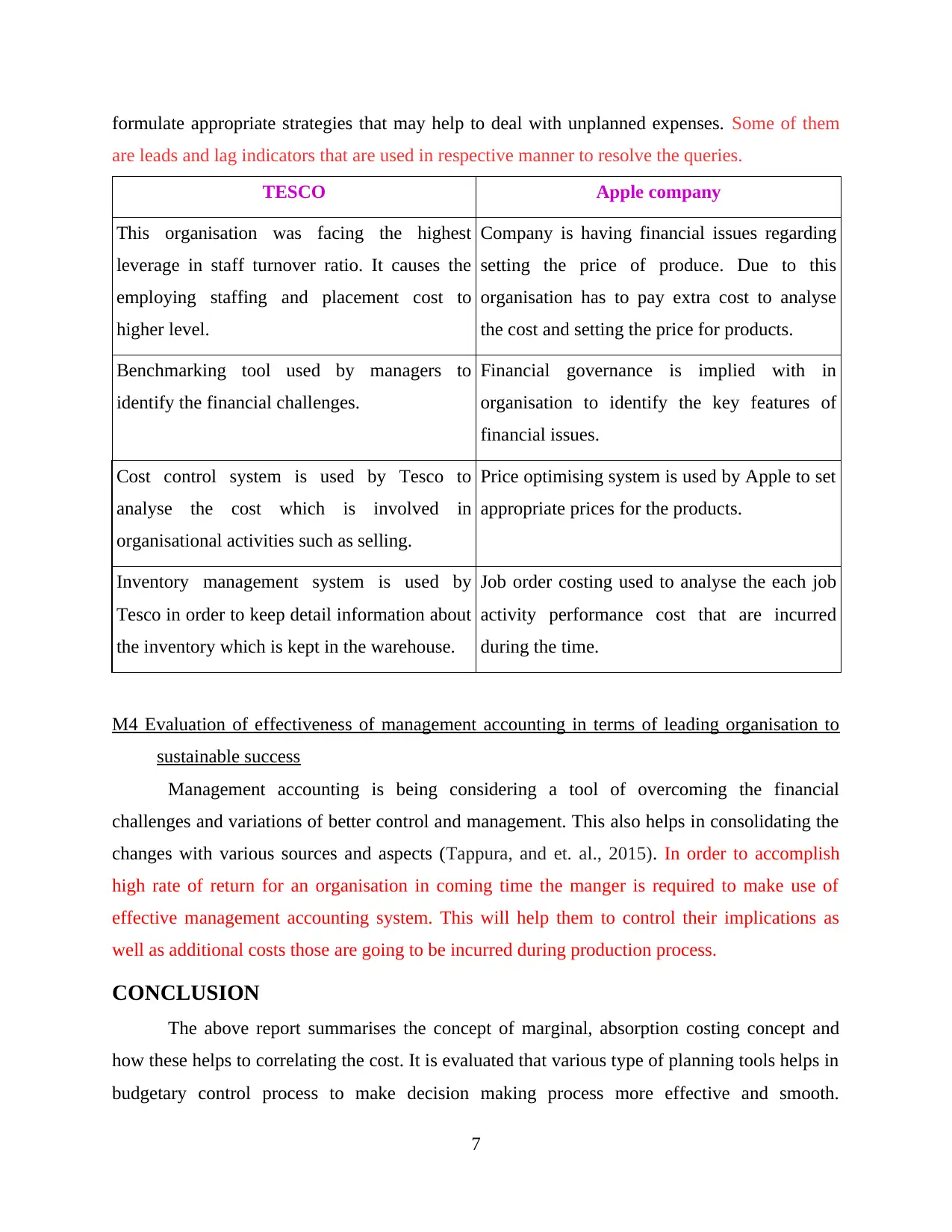
formulate appropriate strategies that may help to deal with unplanned expenses. Some of them
are leads and lag indicators that are used in respective manner to resolve the queries.
TESCO Apple company
This organisation was facing the highest
leverage in staff turnover ratio. It causes the
employing staffing and placement cost to
higher level.
Company is having financial issues regarding
setting the price of produce. Due to this
organisation has to pay extra cost to analyse
the cost and setting the price for products.
Benchmarking tool used by managers to
identify the financial challenges.
Financial governance is implied with in
organisation to identify the key features of
financial issues.
Cost control system is used by Tesco to
analyse the cost which is involved in
organisational activities such as selling.
Price optimising system is used by Apple to set
appropriate prices for the products.
Inventory management system is used by
Tesco in order to keep detail information about
the inventory which is kept in the warehouse.
Job order costing used to analyse the each job
activity performance cost that are incurred
during the time.
M4 Evaluation of effectiveness of management accounting in terms of leading organisation to
sustainable success
Management accounting is being considering a tool of overcoming the financial
challenges and variations of better control and management. This also helps in consolidating the
changes with various sources and aspects (Tappura, and et. al., 2015). In order to accomplish
high rate of return for an organisation in coming time the manger is required to make use of
effective management accounting system. This will help them to control their implications as
well as additional costs those are going to be incurred during production process.
CONCLUSION
The above report summarises the concept of marginal, absorption costing concept and
how these helps to correlating the cost. It is evaluated that various type of planning tools helps in
budgetary control process to make decision making process more effective and smooth.
7
are leads and lag indicators that are used in respective manner to resolve the queries.
TESCO Apple company
This organisation was facing the highest
leverage in staff turnover ratio. It causes the
employing staffing and placement cost to
higher level.
Company is having financial issues regarding
setting the price of produce. Due to this
organisation has to pay extra cost to analyse
the cost and setting the price for products.
Benchmarking tool used by managers to
identify the financial challenges.
Financial governance is implied with in
organisation to identify the key features of
financial issues.
Cost control system is used by Tesco to
analyse the cost which is involved in
organisational activities such as selling.
Price optimising system is used by Apple to set
appropriate prices for the products.
Inventory management system is used by
Tesco in order to keep detail information about
the inventory which is kept in the warehouse.
Job order costing used to analyse the each job
activity performance cost that are incurred
during the time.
M4 Evaluation of effectiveness of management accounting in terms of leading organisation to
sustainable success
Management accounting is being considering a tool of overcoming the financial
challenges and variations of better control and management. This also helps in consolidating the
changes with various sources and aspects (Tappura, and et. al., 2015). In order to accomplish
high rate of return for an organisation in coming time the manger is required to make use of
effective management accounting system. This will help them to control their implications as
well as additional costs those are going to be incurred during production process.
CONCLUSION
The above report summarises the concept of marginal, absorption costing concept and
how these helps to correlating the cost. It is evaluated that various type of planning tools helps in
budgetary control process to make decision making process more effective and smooth.
7
⊘ This is a preview!⊘
Do you want full access?
Subscribe today to unlock all pages.

Trusted by 1+ million students worldwide
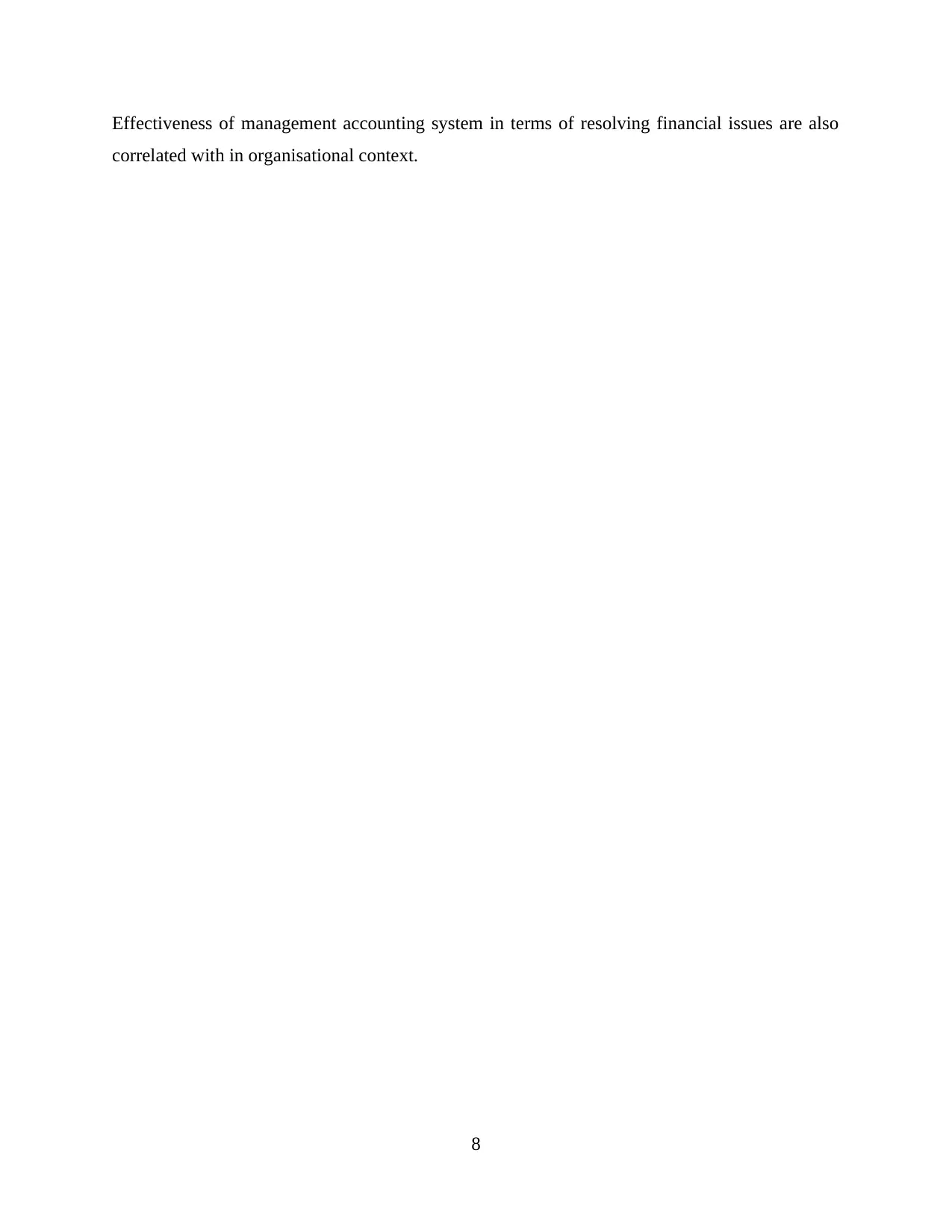
Effectiveness of management accounting system in terms of resolving financial issues are also
correlated with in organisational context.
8
correlated with in organisational context.
8
1 out of 10
Related Documents
Your All-in-One AI-Powered Toolkit for Academic Success.
+13062052269
info@desklib.com
Available 24*7 on WhatsApp / Email
![[object Object]](/_next/static/media/star-bottom.7253800d.svg)
Unlock your academic potential
Copyright © 2020–2025 A2Z Services. All Rights Reserved. Developed and managed by ZUCOL.





